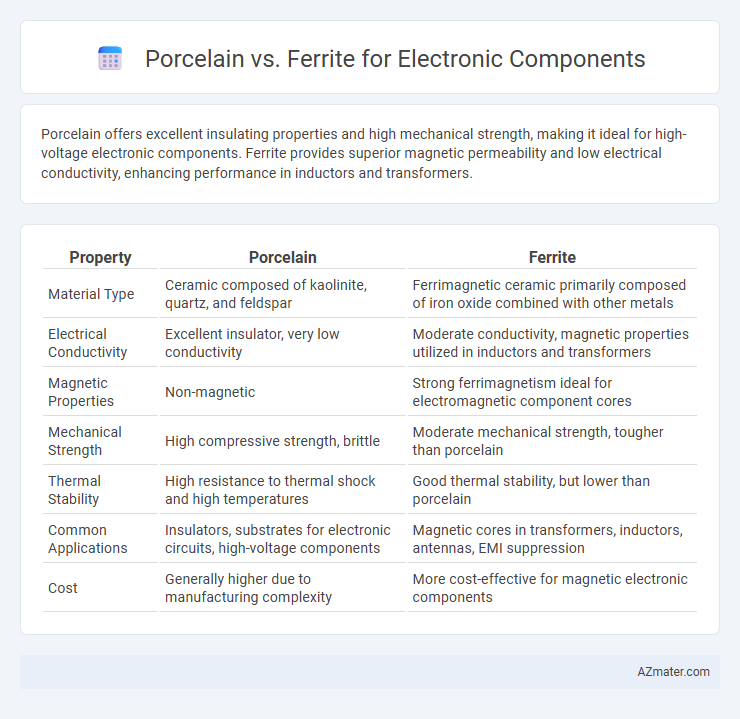Porcelain offers excellent insulating properties and high mechanical strength, making it ideal for high-voltage electronic components. Ferrite provides superior magnetic permeability and low electrical conductivity, enhancing performance in inductors and transformers.
Table of Comparison
| Property | Porcelain | Ferrite |
|---|---|---|
| Material Type | Ceramic composed of kaolinite, quartz, and feldspar | Ferrimagnetic ceramic primarily composed of iron oxide combined with other metals |
| Electrical Conductivity | Excellent insulator, very low conductivity | Moderate conductivity, magnetic properties utilized in inductors and transformers |
| Magnetic Properties | Non-magnetic | Strong ferrimagnetism ideal for electromagnetic component cores |
| Mechanical Strength | High compressive strength, brittle | Moderate mechanical strength, tougher than porcelain |
| Thermal Stability | High resistance to thermal shock and high temperatures | Good thermal stability, but lower than porcelain |
| Common Applications | Insulators, substrates for electronic circuits, high-voltage components | Magnetic cores in transformers, inductors, antennas, EMI suppression |
| Cost | Generally higher due to manufacturing complexity | More cost-effective for magnetic electronic components |
Introduction to Porcelain and Ferrite in Electronics
Porcelain and ferrite are essential materials in electronic component manufacturing due to their unique electrical properties. Porcelain is a ceramic known for its high dielectric strength, excellent insulation, and thermal stability, making it ideal for insulators and capacitors in high-voltage applications. Ferrite, composed of iron oxide mixed with metallic elements, exhibits strong magnetic permeability and low electrical conductivity, commonly used in inductors, transformers, and electromagnetic interference suppression.
Material Composition and Properties
Porcelain, composed primarily of kaolin, feldspar, and quartz, offers excellent electrical insulation, high thermal stability, and mechanical strength, making it ideal for high-voltage applications in electronic components. Ferrite, a ceramic material made from iron oxide mixed with metallic elements like manganese, zinc, or nickel, possesses high magnetic permeability and low electrical conductivity, optimizing it for electromagnetic interference suppression and inductive components. The distinct material compositions define their properties--porcelain excels in dielectric performance and durability, while ferrite specializes in magnetic functionality and frequency response in electronic circuits.
Dielectric Strength Comparison
Porcelain exhibits a higher dielectric strength, typically around 15-20 kV/mm, making it ideal for high-voltage electronic components requiring superior insulation. Ferrite materials, with dielectric strengths generally in the range of 5-10 kV/mm, are preferred for inductors and transformers due to their magnetic properties despite lower insulation capabilities. The dielectric strength difference impacts component durability and performance, especially in applications exposed to high electric fields or voltage spikes.
Magnetic Performance: Ferrite vs Porcelain
Ferrite materials exhibit superior magnetic performance compared to porcelain, featuring high magnetic permeability and low electrical conductivity that reduce eddy current losses in electronic components. Porcelain, primarily used as an insulator, lacks magnetic properties and is unsuitable for applications requiring magnetic responsiveness or inductance. The choice between ferrite and porcelain significantly impacts efficiency and functionality in magnetic components like inductors, transformers, and antennas.
Temperature Stability and Reliability
Porcelain offers superior temperature stability for electronic components due to its high melting point and resistance to thermal shock, making it ideal for applications requiring consistent performance under extreme heat. Ferrite materials exhibit moderate temperature stability but excel in magnetic properties and cost-efficiency, often used in inductors and transformers where temperature variations are less critical. Reliability is higher in porcelain components for harsh thermal environments, while ferrite components provide reliable operation in standard temperature ranges with better frequency response.
Frequency Response Capabilities
Porcelain components exhibit lower frequency response capabilities compared to ferrite due to their higher dielectric losses and limited magnetic permeability, which restrict signal transmission at higher frequencies. Ferrite materials provide superior frequency response, especially in the MHz to GHz range, because of their high magnetic permeability and low eddy current losses, making them ideal for inductors, transformers, and EMI suppression components in high-frequency electronic circuits. Selecting ferrite over porcelain enhances performance in RF applications by enabling efficient signal integrity and minimized energy dissipation.
Applications in Modern Electronic Devices
Porcelain and ferrite materials serve distinct roles in modern electronic devices, with porcelain primarily used as an insulating substrate in high-voltage components and ferrite employed in inductors, transformers, and EMI suppression due to its magnetic properties. Ferrite's high magnetic permeability and low electrical conductivity make it ideal for minimizing electromagnetic interference in communication systems and power supplies. Porcelain's excellent thermal stability and dielectric strength are essential for ensuring reliability in high-temperature environments like power grid insulators and microwave components.
Manufacturing and Cost Considerations
Porcelain components offer superior thermal and electrical insulation but require high-temperature kiln firing, leading to longer production cycles and increased manufacturing costs. Ferrite materials enable faster production through lower temperature sintering and exhibit strong magnetic properties ideal for inductors and transformers, resulting in cost-effective mass manufacturing. Choosing between porcelain and ferrite depends on balancing ceramic processing expenses against performance needs, with ferrite typically providing a more economical solution for high-volume electronic component fabrication.
Longevity and Durability
Porcelain offers superior longevity and durability due to its high resistance to heat, corrosion, and mechanical stress, making it ideal for electronic components exposed to harsh environments. Ferrite, while providing excellent magnetic properties and electrical insulation, tends to have lower mechanical strength and can degrade faster under thermal cycling. Choosing porcelain enhances the lifespan and reliability of electronic components in demanding applications, whereas ferrite suits applications prioritizing magnetic performance over extreme durability.
Choosing the Right Material for Your Project
Porcelain offers superior thermal stability and electrical insulation, making it ideal for high-voltage and high-temperature electronic components, while ferrite provides excellent magnetic properties and high permeability crucial for inductors and transformers. Selecting the right material depends on the application requirements such as operating frequency, temperature tolerance, and magnetic performance. Prioritize porcelain for durability and insulation in harsh environments, and choose ferrite for efficient magnetic energy conversion and EMI suppression in compact electronic designs.

Infographic: Porcelain vs Ferrite for Electronic Component
 azmater.com
azmater.com